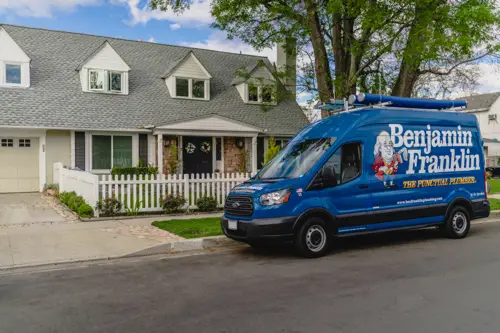
When heavy precipitation leaves standing pools of water in your yard, hearing your sump pump cycle on is comforting. Even when the weather is at its worst, this appliance can keep your basement and other low-lying areas dry. It can also prevent rank odors, mold and mildew growth, and decreased property value.
But if your pump repeatedly cycles on, fails to cycle off, or makes loud grinding and shrieking sounds, you need to take action. Recognizing the signs of increasing stress is the first step in preventing sump pump failure and indoor flooding. At Pensacola Benjamin Franklin Plumbing, we’re sharing everything you should do when your pump is overwhelmed.
What Does It Mean When Sump Pumps Are Overwhelmed
Healthy, high-functioning sump pumps emit a slow, steady hum when active. Typically installed in remote areas, these appliances shouldn’t interrupt indoor conversations. They shouldn’t make it hard to hear your television or engage in quiet activities. Whenever pumps become excessively noisy, homeowners should inspect them for clogs, trapped debris, and dirty filters. Loud, jarring sounds are always indicative of problems.
The length of sump pumps’ cycles vary according to factors like:
- Pump capacity
- Water table levels
- Rainfall amounts
- Landscape quality
However, all pumps should cycle on, clear out incoming water, and then cycle down for short rests. Even during times of heavy precipitation, your pump should have rest periods that last at least one to two minutes. If you never hear your sump pump cycle off or if it never cycles on, it’s time to troubleshoot your unit.
Troubleshooting an Overwhelmed Sump Pump
There’s a clear line between basic troubleshooting and DIY sump pump repairs. Troubleshooting your pump optimizes its operating conditions so that this appliance can function under less stress. Fixing a pump entails opening the unit, tampering with moving parts, and replacing worn or broken components. DIY repairs can instantly void a pump manufacturer’s warranty. In some instances, DIY can also place homeowners at risk of serious injuries.
Check the Sump Pump’s Power Supply
The first thing to check when troubleshooting your sump pump is its electrical connection. If your pump is hardwired into your home’s electrical system, check its circuit breaker. A temporary electrical fault or power surge may have tripped the breaker. If your pump won’t turn on, resetting its breaker could solve the problem.
If your pump is plugged into a dedicated outlet, make sure that no basement or crawlspace activity has dislodged its plug. However, you should never attempt to inspect a pump’s electrical connection or plug it back in if there’s already standing water in the area. To prevent electric shock and potentially fatal electrocution, homeowners can call Pensacola Benjamin Franklin Plumbing instead.
Inspect and Clean the Intake Filter
Your sump pump’s impeller rapidly rotates during each cycle. This motion draws water in and moves it to the discharge pipe. Unfortunately, during times of heavy rain, sump pumps can also draw in tiny twigs, leaves, rocks, and other yard debris. Located near the impeller, the intake filter sieves these things out to keep water moving. When the intake filter is inundated with debris, your pump has a hard time doing its job.
Dirty intake filters can cause sump pumps to make grinding, whistling, or shrieking sounds. They can also cause longer-than-normal cycles, shorter breaks in between cycles, overheating, and short cycling. Short cycling is a common sign of a blocked intake filter. When a pump short cycles, it turns on and then rapidly cycles off, before making any significant difference in water levels.
To clean the intake filter, disconnect your pump at its main power source. Take the sump pump’s cover off to access the impeller, and then check the nearby filter for twigs, leaves, and other obstructions. After pulling out all loose debris, close the pump cover, reconnect the unit’s power supply, and initiate a test cycle. If problems persist, give Pensacola Benjamin Franklin a call. We pride ourselves on providing rapid response times and c. If there’s any delay it’s YOU we pay.
Schedule a Professional Sump Pump Inspection and Maintenance
If your sump pump has an active power supply and if cleaning its intake filter doesn’t alleviate operational stress, schedule professional inspection and maintenance services. If you forgot to schedule a pre-season tune-up, your pump’s issues could be the result of built-up debris, poorly lubricated parts, or worn components. Our sump pump tune-up services will optimize your pump’s performance and keep your home dry throughout the rainy season.
You May Need a Second Sump Pump
If you live in a flood-prone neighborhood, you may need more than one pump to keep the low-lying areas on your property dry. Sump pumps that are tasked with removing more water than they’re built to handle can run longer-than-average cycles or they may run non-stop. With a primary pump and a backup unit, you’ll enjoy greater peace of mind. You’ll also have fewer problems with short cycling, overheating, and noisy operation.
At Pensacola Benjamin Franklin Plumbing, we know just how important sump pumps are for flood-prone homes. If your sump pump is showing signs of being overwhelmed, give us a call today!
